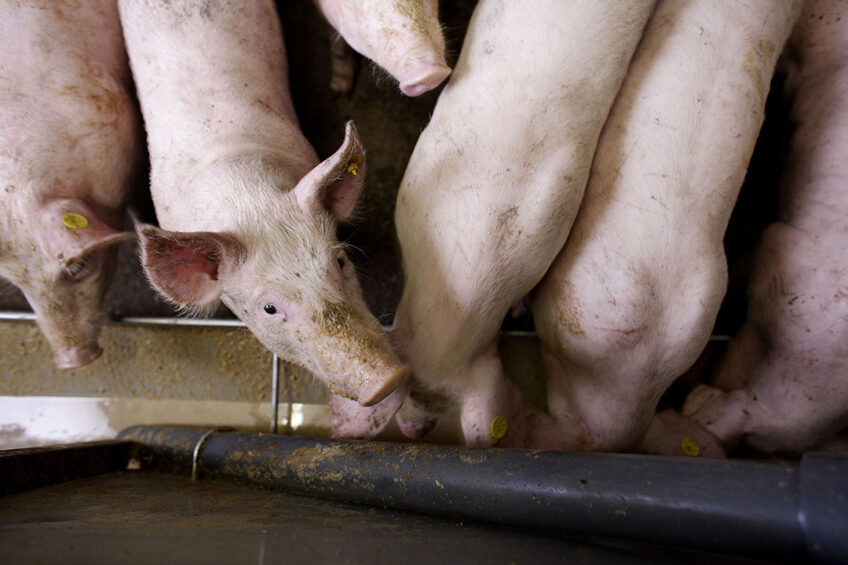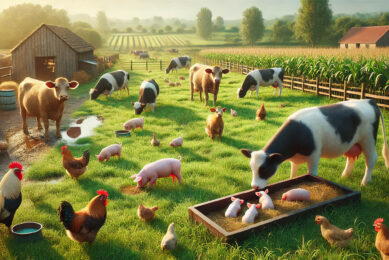Daily-phase feeding contributes to pig feed efficiency

Researchers from China published an article on microbial differences in the pig gut in March 2023. In their research, they compared 3-phase feeding and daily-phase feeding programmes to determine the best impact on feed efficiency. Daily-phase feeding led to less nitrogen excretion into the environment, good use of nutrients, and decreased feed costs.
The growing world population leads to more demand for a stable pork supply to provide animal protein sources. However, intensive pork production systems cause environmental challenges such as greenhouse gas emissions. Feed efficiency is one of the most important issues for a sustainable pig production, because feed comprises 60% to 75% of total production costs. As a result, it is necessary to use. among other things, sutiable feeding strategies to increase pork production sustainability.
The daily-phase feeding programme
The daily-phase feeding programme applied mixed feed with a gradual daily change of 2 adjacent phase feeds from 2 feed silos to 2 pig pens. The programme was designed using adjacent phase feed based on an empirical model which predicts pig growth and its nutrient requirements.
The 3-phase feeding programme
The 3-phase feeding programme was supplied with fixed feed for phase I, phase II, and phase III, which started at 81, 101, and 132 days of age.
The research team assigned pigs randomly to each feeding programme.
Data collection
204 Landrace × Yorkshire pigs of 75 days of age were randomly assigned to either the 3-phase feeding or daily-phase feeding programme. The research team calculated the pigs’ average daily feed intake, average daily gain, and the feed conversion ratio.
The researchers also collected fresh faecal and blood samples during the trial. They fixed duodenal, jejunal and ileal tissues in 4% paraformaldehyde to evaluate gut morphology. This included villus height, crypt depth, and the villus height to crypt depth ratio.
An autoanalyser measured the concentrations of serum total protein, blood urea nitrogen, alkaline phosphatase, albumin, glutamic-pyruvic transaminase, glutamic-oxalacetic transaminase, creatinine and triglyceride. The team analysed serum endotoxin, diamine oxidase, D-lactic acid concentration using commercial kits.
They also extracted the total genomic DNA of faecal bacteria using a commercial kit. The team also assessed the integrity of the DNA. They used a high-resolution tandem mass spectrometer to detect metabolites in the blood. The researchers extracted te total RNA from the jejunum of pigs. They also measured the relative expression of genes associated with anti-oxidation by a quantitative polymerase chain reaction.
Advantages of the daily-phase feeding programme
The researchers found that the daily-phase feeding programme improved feed efficiency, lowered the feed conversion ratio in growing-finishing pigs, and reduced the intake of crude protein, lysine, crude fibre, ash, ether extract, net energy and total phosphorus.
In addition to that, the daily-phase feeding programme improved the intestinal function, permeability, and morphology. It also increased the jejunal and ileal villus height to crypt depth ratio, and enhanced amylase, lactase, sucrase and ALP in the duodenum and jejunum, while it decreased the trend in pepsin in the pancreas in growing-finishing pigs.
Furthermore, the daily-phase feeding programme lowered plasma diamine oxidase concentration, increased the activities of total antioxidant capacity and the total superoxide dismutase of the jejunum, and the trend in glutathione peroxidase. It also enhanced plasma metabolites in the amino acid metabolism pathways including phenylalanine, tyrosine and tryptophan biosynthesis and phenylalanine metabolism.
Impact of the daily-phase feeding programme on gut microbiota
The daily-phase feeding programme decreased the relative abundance of Oscillibacter. It increased the abundance of potentially beneficial microbes such as Paraprevotella and Prevotella. At the family level, the most abundant bacterial families in the pig gut consisted of Prevotellaceae, Lactobacillaceae, and Lachnospinaceae. At the species level, the pig gut harboured more Prevotella copri DSM18205, and Paraprevotella clara YIT11840 but fewer Oscillibacter valericigenes.
Prevotella copri DSM18205, and Paraprevotella clara YIT11840 are the 2 key microbes related to high levels of phenylalanine metabolites in plasma that improve feed efficiency. Phenylalanine improves host metabolism by enhancing the intestinal barrier function, showing anti-inflammatory properties and antioxidant activities, and strengthening the immune function. Paraprevotella, Prevotella and Oscillibacter correlate with the feed conversion ratio. Prevotella, a core genus of pigs, produces enzymes that can degrade complex dietary polysaccharides, then improve fiber digestibility and feed efficiency.
Daily-phase feeding is a practical and precise solution
In conclusion, the daily-phase feeding programme is a practical and precise solution that adjusted the whole herd daily, and provided nutritional requirements daily. It led to less excretion of nitrogen and phosphorus into the environment, and its use saved on feed costs.











